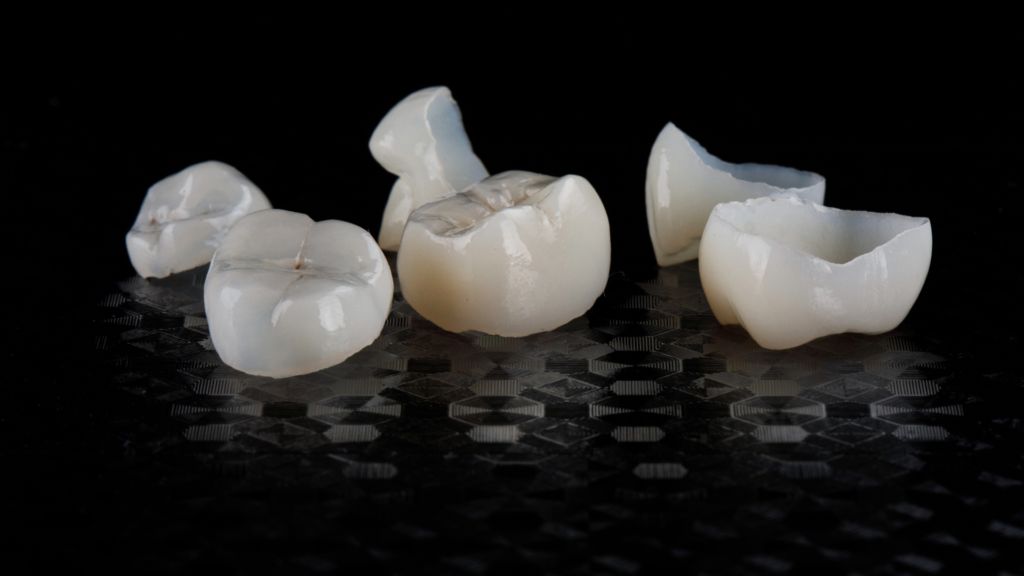What are Dental Crowns Made of?

Understanding Dental Crowns
Definition and Purpose
Dental crowns, often provided by clinics like Giant Smiles Dental, are custom-fitted tooth prosthetics that are used to cover a damaged or decayed tooth. They restore the tooth’s shape, size, strength, and improve its appearance. Crowns can be made from various materials, each with unique benefits and applications.
The primary purposes of dental crowns include:
- Protecting a weak tooth from breaking or to hold together parts of a cracked tooth.
- Restoring an already broken tooth or a tooth that has been severely worn down.
- Covering and supporting a tooth with a large filling when there isn’t a lot of tooth left.
- Holding a dental bridge in place.
- Covering misshapened or severely discolored teeth.
- Covering a dental implant.
Dental crowns serve not only as a restorative solution but also offer cosmetic benefits, making them a popular choice for improving dental aesthetics.
Types of Dental Crowns
Dental crowns come in various types, each designed to cater to different needs and preferences. Giant Smiles Dental offers a range of crown types to ensure that every patient finds the perfect fit for their oral health requirements. The primary types of dental crowns include:
- Metal Crowns: Known for their durability and strength, ideal for molars that are not visible.
- Porcelain Crowns: Highly aesthetic and can be matched to the color of your natural teeth.
- Composite Resin Crowns: A cost-effective option that provides a decent balance between strength and aesthetics.
- Ceramic Crowns: Offer a natural appearance and are often used for front teeth.
- Porcelain Fused to Metal (PFM) Crowns: Combine the strength of metal with the aesthetics of porcelain.
Each type of crown has its unique benefits and limitations. Giant Smiles Dental professionals can help you determine which material is best suited for your tooth based on its location, function, and the aesthetic demands of your smile.
It’s important to consider factors such as the crown’s longevity, appearance, and compatibility with your natural teeth. Your dentist at Giant Smiles Dental will guide you through the selection process, ensuring that you receive a crown that not only looks great but also functions effectively for years to come.
The Role of Dental Crowns in Oral Health
Dental crowns play a pivotal role in restoring and maintaining oral health. They are not only used to repair damaged teeth but also to protect teeth from further decay or damage. Giant Smiles Dental emphasizes the importance of crowns in supporting dental structures and ensuring the longevity of dental work.
- Protection: Crowns shield the underlying tooth from external influences, such as bacteria and chewing forces.
- Restoration: They restore the functionality of a tooth that has been compromised by decay or injury.
- Aesthetic Improvement: Crowns can also improve the appearance of teeth that are discolored or poorly shaped.
The success of a dental crown is not solely dependent on the material or the dentist’s skill. It is also a result of the patient’s commitment to proper oral hygiene and regular dental check-ups.
Choosing the right type of crown is crucial, as each material offers different benefits. At Giant Smiles Dental, patients are provided with detailed information to make an informed decision that best suits their oral health needs and lifestyle.
Materials Used in Dental Crowns
Metal Alloys
Metal alloys have been a traditional choice for dental crowns due to their durability and strength. At Giant Smiles Dental, we often recommend metal crowns for molars that are not visible when smiling, as they can withstand the heavy biting forces. Common metals used include gold, palladium, nickel, and chromium.
Metal crowns are less likely to chip or break compared to other types of crowns, making them a practical option for patients who need a long-lasting solution.
The following table outlines the typical composition of metal alloy crowns:
| Metal | Percentage |
|---|---|
| Gold | 40-60% |
| Palladium | 20-30% |
| Nickel | 10-15% |
| Chromium | 5-10% |
While metal crowns are highly durable, they are not the most aesthetically pleasing option. For those who prioritize appearance, other materials such as porcelain or ceramic may be more suitable.
Porcelain and Ceramic
Porcelain and ceramic crowns are highly favored for their ability to mimic the natural translucency and color of real teeth. Giant Smiles Dental often recommends these materials for front tooth restorations due to their superior aesthetic qualities. However, while they excel in appearance, they may not be as strong as metal crowns, making them less suitable for molars that endure the brunt of chewing forces.
Porcelain and ceramic crowns are crafted to provide a seamless match with your natural teeth, ensuring that your smile looks as authentic as possible.
The following list outlines the key attributes of porcelain and ceramic crowns:
- Aesthetic excellence with color matching and translucency
- Less durable than metal, more prone to chipping
- Ideal for people with metal allergies
- Typically require more tooth structure removal
When considering a dental crown, it’s important to discuss with your dentist at Giant Smiles Dental the best material suited for your specific needs and lifestyle.
Composite Resin
Composite resin crowns are a popular choice for those seeking a balance between aesthetics and affordability. Giant Smiles Dental often recommends composite resin for its tooth-like appearance and moderate durability. These crowns are crafted from a mixture of plastic and ceramic compounds, which can be easily molded to match the natural contours of your teeth.
- Aesthetics: Mimics natural tooth color and translucency
- Repairability: Easily repaired if damaged
- Cost-Effective: Less expensive than porcelain or metal crowns
Composite resin crowns, however, are not as strong as metal or ceramic crowns and may wear down more quickly over time. For patients who prioritize a natural look and are seeking a more cost-conscious option, composite resin can be an excellent choice.
Composite resin crowns require meticulous care and regular check-ups at Giant Smiles Dental to maintain their appearance and function. While they are more prone to staining and abrasion than porcelain crowns, with proper maintenance, they can serve as a functional and aesthetic restoration for many years.
Porcelain Fused to Metal
Porcelain fused to metal (PFM) crowns are a hybrid between the durability of metal and the aesthetic appeal of porcelain. They offer a balance of strength and appearance, making them a popular choice for restoring teeth that require both functional support and a natural look. At Giant Smiles Dental, PFM crowns are tailored to match the color of your surrounding teeth, ensuring a seamless integration with your smile.
PFM crowns are particularly beneficial for teeth that undergo significant stress from biting and chewing, such as molars. The metal alloy base provides robust structural support while the porcelain exterior is crafted to mimic the translucency and color of natural tooth enamel.
The longevity of PFM crowns can be influenced by several factors, including the quality of materials used and the precision of the fit. Here’s a brief overview of considerations when opting for PFM crowns:
- Durability: The metal substructure offers high resistance to wear and fracture.
- Aesthetics: Porcelain provides a tooth-like appearance, though the metal base can sometimes show through as a dark line near the gum.
- Biocompatibility: While generally well-tolerated, some patients may have sensitivities to certain metal alloys.
- Cost: PFM crowns are often more affordable than all-ceramic options but can be more expensive than metal crowns alone.
The Fabrication Process of Dental Crowns
Initial Consultation and Tooth Preparation
The journey to a restored smile with a dental crown begins at Giant Smiles Dental with an initial consultation. During this visit, your dentist will evaluate the health of your teeth and discuss the best crown options for your specific needs. Tooth preparation is a critical step that involves reshaping the tooth to ensure a proper fit for the crown. This process may involve removing decayed or weakened portions of the tooth and building up the structure to support the crown.
The goal of tooth preparation is not only to create a stable base for the crown but also to maximize the longevity and comfort of your restoration.
Following the preparation, your dentist will provide you with a temporary crown to protect the tooth while your permanent crown is being fabricated. This temporary solution allows you to maintain normal function and appearance until your next appointment. The steps involved in tooth preparation include:
- Numbing the tooth and surrounding tissue to ensure comfort during the procedure.
- Removing any decay and shaping the tooth to receive the crown.
- Taking impressions of the prepared tooth and adjacent teeth for crown fabrication.
- Placing a temporary crown to protect the tooth until the permanent crown is ready.
Impression Taking and Crown Design
Once the tooth is prepared, the next step at Giant Smiles Dental is to take an accurate impression of your mouth. This impression is crucial as it will be used to design a crown that fits perfectly with your bite and matches the shape of your other teeth. The precision of this step is paramount to ensure the comfort and functionality of the final crown.
- The dentist applies a dental putty or digital scanning device to capture the shape of the prepared tooth and surrounding teeth.
- The impression is then sent to a dental laboratory where the crown will be designed.
- During the design phase, attention is given to the crown’s occlusal surfaces to ensure a proper bite alignment.
At Giant Smiles Dental, we utilize state-of-the-art technology to create a digital blueprint of the crown, which is then used to manufacture the crown with exact specifications for a seamless fit.
Manufacturing Techniques
The manufacturing of dental crowns has evolved significantly with advancements in dental technology. Giant Smiles Dental utilizes state-of-the-art techniques to ensure that each crown is crafted with precision and tailored to the individual needs of the patient.
The process typically involves the following steps:
- Digital or physical impressions are taken of the prepared tooth.
- The crown is designed using computer-aided design (CAD) software.
- Computer-aided manufacturing (CAM) or 3D printing technology is used to create the crown from the chosen material.
- The crown undergoes a detailed inspection for quality assurance before being prepared for the final fitting.
The precision of CAD/CAM technology allows for a fit that is remarkably close to the natural tooth structure, enhancing both the function and aesthetics of the dental crown.
Choosing the right manufacturing technique is crucial, as it impacts the crown’s durability, appearance, and overall success. Giant Smiles Dental prides itself on offering a range of options to suit various needs and preferences.
Final Fitting and Adjustment
Once the dental crown has been meticulously crafted, the final step in the process is the fitting and adjustment phase. This is a critical stage where the dentist at Giant Smiles Dental ensures that the crown fits comfortably and functions properly within the patient’s mouth. During the fitting, the dentist will check the crown for proper bite alignment and make any necessary adjustments to achieve the ideal fit.
The goal is to ensure that the crown not only restores function but also feels natural and does not cause any discomfort to the patient.
After the fitting, patients may be asked to follow certain guidelines to care for their new crown while it settles. Here is a brief list of post-fitting recommendations:
- Avoid chewing hard foods on the crown for a short period after fitting.
- Report any sensitivity or discomfort immediately to your dentist.
- Maintain good oral hygiene to protect the crown and surrounding teeth.
The success of a dental crown is not just in its creation but in the precision of its final placement. Giant Smiles Dental takes pride in ensuring that each step of the crown fabrication and fitting process is performed with the utmost care and attention to detail.
Advantages and Disadvantages of Different Crown Materials
Durability and Strength
When choosing a dental crown, one of the primary considerations is its durability and strength. These attributes are crucial as they determine how well the crown will withstand the daily demands of chewing and biting. At Giant Smiles Dental, we understand that the longevity of a dental crown is a significant concern for our patients.
The material selected for a dental crown directly impacts its durability and resistance to wear. Each material has its own set of properties that cater to different needs and preferences.
Here’s a quick comparison of the most commonly used materials:
- Metal Alloys: Known for their exceptional strength and ability to withstand biting forces; ideal for molars where the pressure is greatest.
- Porcelain and Ceramic: Offer a balance between durability and aesthetic appeal, making them popular for visible teeth.
- Composite Resin: Less durable than metal or porcelain but can be more easily repaired or reshaped.
- Porcelain Fused to Metal: Combines the strength of metal with the aesthetic quality of porcelain, providing a durable and visually pleasing option.
It’s important to discuss with your dentist at Giant Smiles Dental the best material for your specific situation, taking into account factors such as the location of the tooth and your personal dental history.
Aesthetic Appeal
When it comes to the aesthetic appeal of dental crowns, Giant Smiles Dental understands that the appearance of one’s teeth is paramount. The choice of material can significantly affect the crown’s look and how it blends with the natural teeth.
- Porcelain and Ceramic: These materials are favored for their ability to mimic the translucency and color of natural teeth.
- Composite Resin: Offers a good balance between aesthetics and affordability, though it may not match the natural teeth as closely as porcelain.
- Metal Alloys: While durable, they are less popular for visible teeth due to their metallic color.
- Porcelain Fused to Metal (PFM): Provides a better aesthetic than metal crowns with a porcelain coating that can be matched to the color of adjacent teeth.
The goal is to achieve a natural-looking smile that enhances confidence and quality of life. Giant Smiles Dental prides itself on providing crowns that not only restore function but also offer a pleasing aesthetic that meets the individual needs of each patient.
Biocompatibility and Allergies
When choosing a dental crown, it’s crucial to consider the biocompatibility of the materials used. Biocompatibility refers to how well the material coexists with the body’s natural tissues without causing adverse reactions. Allergic reactions to crown materials, while rare, can occur and may lead to discomfort or other complications.
At Giant Smiles Dental, we prioritize your safety by offering a range of biocompatible materials suited to your individual needs.
Certain materials are known for their high biocompatibility, such as ceramic and porcelain, which are less likely to cause allergic reactions. However, some patients may have sensitivities to metal alloys used in crowns. Here’s a quick overview of common materials and their associated risks:
- Ceramic/Porcelain: Highly biocompatible; rare instances of allergies
- Metal Alloys: Potential for metal allergies; nickel and beryllium are common culprits
- Composite Resin: Generally biocompatible; can include additives that some individuals are sensitive to
- Porcelain Fused to Metal (PFM): Biocompatibility depends on the underlying metal alloy
Patients should discuss any known allergies or sensitivities with their dentist at Giant Smiles Dental to ensure the selection of the most suitable crown material. This conversation is a critical step in the process of obtaining a dental crown that not only restores function but also maintains overall oral health.
Cost Considerations
When considering dental crowns, cost is a significant factor for many patients. The price of a dental crown varies widely depending on the material used and the complexity of the procedure. Metal alloys, while durable, tend to be less expensive than porcelain or ceramic crowns. Composite resin crowns offer a middle ground in terms of cost. However, for the ultimate blend of durability and aesthetics, porcelain fused to metal crowns may be more costly.
At Giant Smiles Dental, we understand that budget is a key concern, and we strive to provide options that accommodate various financial situations. Below is a simplified cost comparison of different crown materials:
| Material Type | Average Cost Range |
|---|---|
| Metal Alloys | $500 – $1,500 |
| Porcelain/Ceramic | $800 – $3,000 |
| Composite Resin | $600 – $1,500 |
| Porcelain Fused to Metal | $700 – $2,500 |
It’s important to note that while initial costs are a factor, the long-term value of a crown should also be considered. A less expensive crown that requires replacement more frequently may end up being more costly over time compared to a more durable, albeit initially expensive, option.
Patients should also consider the potential for additional costs, such as those for preparatory procedures or follow-up care. Insurance coverage can significantly offset these expenses, and financing options may be available to help manage out-of-pocket costs.
Maintaining Dental Crowns
Daily Oral Hygiene Practices
Maintaining the integrity and appearance of your dental crowns is crucial for their longevity. Daily oral hygiene practices are essential to prevent plaque buildup and potential decay around the crown margins. At Giant Smiles Dental, we recommend the following routine to care for your crowns:
- Brush your teeth at least twice a day using a soft-bristled toothbrush.
- Floss daily, making sure to gently clean around the crown area to avoid dislodging it.
- Use an antiseptic mouthwash to help kill bacteria and maintain healthy gums.
Consistent oral hygiene not only protects your dental crowns but also contributes to your overall oral health. Remember, a crown does not make the tooth invulnerable to decay and gum disease.
It’s important to use non-abrasive toothpaste to avoid scratching the crown’s surface. For patients with dental crowns, Giant Smiles Dental often suggests a check-up schedule that is more frequent than the standard six-month interval. This ensures that any issues can be identified and addressed promptly, safeguarding your dental investment.
Regular Dental Check-Ups
Regular dental check-ups are crucial for the longevity and health of your dental crowns. Giant Smiles Dental recommends scheduling visits every six months to ensure that your crowns are in top condition. During these check-ups, your dentist will examine the crowns for any signs of wear or damage and assess the health of the surrounding gum tissue.
- Examination of crown integrity and fit
- Assessment of gum health around the crown
- Professional cleaning to remove plaque and tartar
- Identification and management of any issues early on
Regular check-ups help prevent potential problems and extend the life of your dental crowns. It’s an investment in your oral health that pays off in the long run.
By maintaining a consistent schedule with your dentist, you can avoid complications that might require more extensive and costly procedures. Remember, proactive care is the key to keeping your smile bright and your crowns functional for years to come.
Dealing with Wear and Damage
Even the most durable dental crowns from Giant Smiles Dental are not immune to wear and damage over time. It’s essential to recognize the signs of wear and take appropriate action to ensure the longevity of your crown.
- Regularly inspect your crown for any signs of wear, such as cracks or chips.
- Avoid using your crowns as tools to open packaging or bite hard objects.
- If you notice any damage, schedule an appointment with your dentist immediately to assess the need for repair or replacement.
Early detection and intervention can prevent further damage to the crown and underlying tooth structure, saving you time and discomfort in the long run.
Remember, maintaining your dental crowns is a collaborative effort between you and your dental care provider. By following the recommended care practices, you can help extend the life of your crowns and maintain a healthy, beautiful smile.
When to Replace a Dental Crown
Dental crowns from Giant Smiles Dental are designed to last for many years, but they do not last forever. Recognizing when to replace a dental crown is crucial for maintaining oral health and ensuring the functionality of your teeth. Generally, a dental crown may need replacement due to wear and tear, damage, or aesthetic concerns.
- Wear and Tear: Over time, crowns can become worn down, especially if you grind your teeth or have a misaligned bite.
- Damage: Crowns can crack or chip from trauma or biting on hard objects. Regular check-ups can help identify damage early.
- Aesthetic Changes: For crowns visible when you smile, discoloration or changes in your natural teeth may prompt a replacement for a uniform appearance.
The lifespan of a dental crown can be affected by several factors, including the material of the crown, the precision of fit, and your oral hygiene practices. While the crown itself cannot become discolored, the underlying tooth can, affecting the overall look. This is particularly relevant if you’re wondering how long does teeth whitening last, as whitening treatments do not affect crowns.
It’s important to consult with your dentist at Giant Smiles Dental if you notice any changes in your crown or have concerns about its condition. They can provide guidance on whether a replacement is necessary and what options are available to you.
Frequently Asked Questions
What is a dental crown and why is it used?
A dental crown is a custom-fitted cap that covers a damaged or decayed tooth to restore its shape, strength, and appearance. It’s used to protect the tooth, improve its function, and enhance aesthetic appeal.
What are the different types of dental crowns available?
The main types of dental crowns include metal alloys, porcelain and ceramic, composite resin, and porcelain fused to metal. Each type has its own advantages and is chosen based on the tooth’s location, function, and aesthetic requirements.
How long does the process of getting a dental crown take?
The process typically involves two visits to the dentist: the first for tooth preparation and impression taking, and the second for fitting and adjusting the final crown. The overall timeframe can vary, but it usually takes a couple of weeks from start to finish.
What factors should I consider when choosing the material for my dental crown?
When selecting a material for your dental crown, consider factors like durability, strength, aesthetic appeal, biocompatibility, potential allergies, and cost. Your dentist can help you decide which material is best suited for your specific needs.
How do I care for my dental crown to ensure its longevity?
Maintain good oral hygiene by brushing twice a day, flossing regularly, and avoiding hard or sticky foods that can damage the crown. Additionally, visit your dentist for regular check-ups and professional cleanings.
Can a dental crown last a lifetime, or will it need to be replaced?
While dental crowns are designed to be long-lasting, they may not last a lifetime. The lifespan of a crown depends on the material used and how well it’s cared for. On average, crowns can last between 5 to 15 years before they may need to be replaced due to wear or damage.






